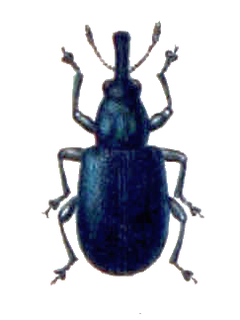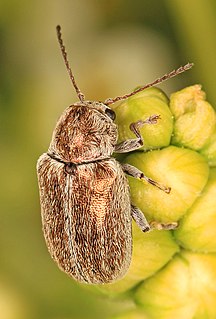
The Donaciinae are a subfamily of the leaf beetles, or Chrysomelidae, characterised by distinctly long antennae. They are found in mainly the Northern Hemisphere, with some species found in the Southern Hemisphere.

Erotylidae, or the pleasing fungus beetles, is a family of beetles belonging to Cucujoidea containing over 100 genera. In the present circumscription, it contains 6 tribes and 10 subfamilies. In other words, the narrowly circumscribed Erotylidae correspond to the subfamily Erotylinae in the definition sensu lato. There are doubts on the monophyly of lower ranked taxa within Erotylidae, with further phylogenetic studies requiring better sampling and studies of unexplored character sets, for example the metendosternite and penile flagellum, which are generally lacking detailed morphological studies within the Coleoptera literature.

Coccinellinae is a subfamily of lady beetles in the family Coccinellidae. There are at least 20 genera and 90 described species in Coccinellinae.

Auletobius is a genus of leaf and bud weevils in the family Attelabidae. There are at least 220 described species in Auletobius.
Metachroma is a genus of leaf beetles in the subfamily Eumolpinae. It is distributed from Ontario, Canada to Mendoza, Argentina, including the Antilles. It has also been suggested that the genus extends to the Pacific Islands, though this is not confirmed. There are about 140 described species in Metachroma, 40 of which are found north of Mexico. An extinct species is also known from the Eocene of the United States.

Murmidiidae is a family of beetles in the superfamily Coccinelloidea, formerly included within the family Cerylonidae. The family contains thirty-four described species in four genera, which are found worldwide. They are typically found under the bark of recently dead trees, and are thought to be mycophagous. The species Murmidius ovalis, found worldwide, is noted as a pest of stored food.
Glyptina is a genus of flea beetles in the family Chrysomelidae. There are about 15 described species in Glyptina.
Glyptoscelis juniperi is a species of leaf beetle. It is found in California in the United States.

Glyptoscelis is a genus of leaf beetles in the subfamily Eumolpinae. There are 38 species of Glyptoscelis described from North, Central and South America. There are also three species of Glyptoscelis known from the West Indies, though they are wrongly placed in the genus. In addition, a single species was described from Hunan, China in 2021.
Acalymma trivittatum, the western striped cucumber beetle, is a species of leaf beetle in the family Chrysomelidae. It is found in Central America and North America. It is considered a key pest on crops in the Cucurbitaceae family.
Promecosoma arizonae is a species of leaf beetle. It is found in southern Arizona and in New Mexico in the United States, as well as in Mexico.
Glyptoscelis albicans is a species of leaf beetle. It is found in the southeastern United States.
Glyptoscelis alternata is a species of leaf beetle. It is found in the western United States.
Metachroma luridum, the dark-sided metachroma, is a species of leaf beetle. It is found in the eastern United States, where its range spans from Texas to Florida and New Jersey, and in Mexico. Its length is between 3.5 and 4.0 mm.
Glyptoscelis illustris is a species of leaf beetle. Its range spans from California to Oregon in the United States.
Graphops marcassita is a species of leaf beetle. It is found in North America.
Glyptoscelis prosopis is a species of leaf beetle. Its range spans from southern Texas to Mexico and Central America. It was first described by the American entomologist Charles Frederic August Schaeffer in 1905.
Glyptoscelis pubescens, known generally as the hairy leaf beetle or pine chrysomelid, is a species of leaf beetle. It is found in eastern North America. It is a potential pest of pine trees.
Glyptoscelis albida is a species of leaf beetle. It is found in western North America.
Glyptoscelis cryptica is a species of leaf beetle. It is found in the central United States.





